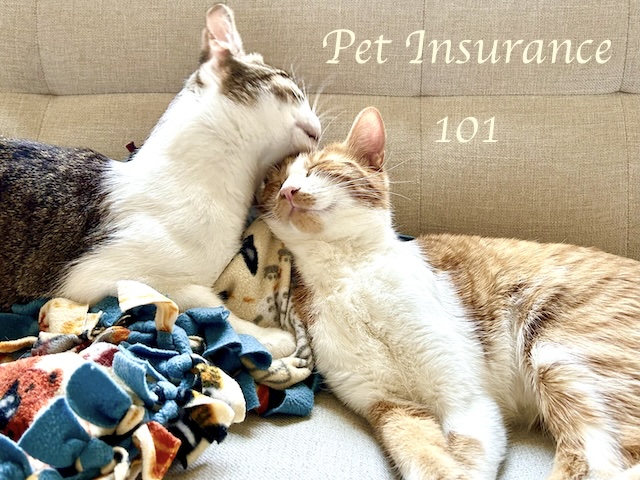

During the pandemic, the number of people adopting or buying pets increased significantly. Because people can no longer socialize and gather together regularly, the companionship of pets has become even more important. In some places, neighbors even came to “borrow” their dogs for walks, because during this special period of restricted access, “walking the dog” is a legitimate excuse to go out every day.
However, in North America, just like medical care for people, pet care is incredibly expensive, potentially bankrupting owners. Therefore, purchasing appropriate pet insurance is crucial. How do you determine if your pet needs insurance? How do you choose an insurance company and type of policy? What are the pitfalls of buying pet insurance? Let’s take a look at the recommendations from the review website Wirecutter.
1. Who should buy pet insurance?

If your pet is relatively healthy and you can afford the premiums, and you can’t afford tens of thousands in veterinary bills, you should buy pet insurance. Good insurance can save you from huge out-of-pocket expenses—and it also means you don’t have to make the heartbreaking choice of saying goodbye to your pet because you can’t afford its care.
“Relatively healthy” is important. Even if your pet has only had a few minor veterinary visits or has a chronic but manageable condition, you can and should purchase insurance.
If your pet is older and already has serious health issues like cancer, surgery, or loss of mobility, you may not get much help from a new insurance plan because pre-existing conditions aren’t covered; insurance companies only cover issues that develop after your pet’s policy is purchased. If you decide to switch from one insurance company to another, any issues that occurred before the switch will become a “pre-existing condition,” even if it was covered by your first plan. However, depending on your pet’s condition and the likelihood of future diagnoses, an insurance plan may still be worth considering. Ask your veterinarian to help you understand the risks of certain conditions based on your pet’s age, breed, and medical history, and whether they require costly care.
Some people save money for their pet’s medical needs, but remember that if your pet doesn’t have insurance, a single emergency veterinary visit could wipe out years of personal savings. Furthermore, as your pet ages, the cost of care and likelihood of illness increase, potentially exceeding your savings. Radiation therapy for some tumors can cost $10,000, a kidney transplant can reach $15,000, and a bone marrow transplant can cost over $20,000.
However, if you live comfortably and can afford large bills, you might prefer to keep the premiums out of your own pocket, as the cost of insuring your pet over its lifetime could be twice as much as a single radiation treatment. However, your pet’s illness can become a long-term problem, and without an insurance plan, you could end up with thousands of dollars in veterinary bills for repeated treatments.
2. What does pet insurance include?

Unlike human health insurance, pet insurance doesn’t cover preventative care like routine checkups, dental care, or vaccinations. Purchasing pet insurance only makes sense for things you can’t predict, like ear infections, broken bones, and chronic illnesses.
For health care, including annual checkups and vaccinations, it’s better to set aside money each month rather than buy a broader policy that might cover these items. Some companies do offer health benefits, but these plans are more expensive, and if you miss a checkup, you lose the services you’ve already paid for and may even default on your policy.
Insurance plans also exclude coverage for pre-existing conditions and treatment for animals that have been abused or neglected. If owners miss out on vaccinations and their pets become ill as a result, coverage is also excluded. For example, if your dog gets Bordetella (kennel cough) and you don’t get the Bordetella vaccine up to date, the insurance company won’t cover the cost of treatment.
There are also a host of (outrageous) exclusions, such as the effects of war, nuclear weapon fallout, biological attacks, mutant flus, and zombie outbreaks.
3. When should I buy pet insurance?

When it comes to pet insurance, the younger your pet is, the more cost-effective your policy will be. Although wellness exams (the most common expense for young pets) aren’t covered by most insurance plans, premiums are lower for younger pets, so the earlier you purchase insurance, the better.
Insurance representatives told us that premiums for all pets covered by the company have increased by about 6% each year since 2012. In 2017, our imaginary pet (a fictitious pet used to calculate premiums) cost an average of $52 per month to insure. In 2021, the cost of insuring a new pet is $143 per month—a 275% increase.
While we believe you should insure your pet as early as possible to maximize your policy benefits, this doesn’t mean you shouldn’t insure older pets or pets with genetic conditions.
According to our estimates (as shown above), insuring a cat between the ages of 12 and 18 would cost over $26,000 in premiums. You could save over $7,000 by insuring them from age 6 months to 18. That’s not cheap, but it’s a better deal than paying out-of-pocket to diagnose and treat cancer or genetic diseases for your senior pet.
While pets with pre-existing conditions (such as cancer diagnosed before you purchase your policy) are not covered, it’s still worthwhile to insure them against other conditions in case they arise later. In most cases, these conditions in older pets will be covered like any other claim, as long as the veterinarian didn’t document them as suspected, symptomatic, or pre-existing before you purchased your policy.
We also recommend choosing a plan with no (or very short) waiting period. For example, Healthy Paws Pet Insurance’s hip dysplasia coverage has a 12-month waiting period. However, hip dysplasia is most common in large breeds (both purebreds and mixed breeds are at risk), and early signs may appear before a puppy’s first birthday. A 12-month waiting period would essentially render the coverage useless.
4. How to find suitable insurance?

To find the right insurance plan, you need to understand your pet’s medical history and your budget. Then, before getting a quote, list the things that are most important to you, such as the types of accidents and illnesses you want covered and the percentage you’re willing to pay.
Get quotes from several reputable providers and compare insurance types to see what options work for your budget. Previously, we’ve recommended Trupanion, Healthy Paws Pet Insurance, and Figo Pet Insurance to our readers. However, prices and coverage vary widely depending on your location and the specific circumstances of your pet, so it’s important to compare carefully.
Here are some things to look for when you’re looking at quotes:
Policy Value: We strongly recommend that you only consider plans that offer unlimited annual benefits, flexible deductibles, and reimbursement rates above 70%. When you request a quote online, you can adjust the benefit limits, deductibles, and reimbursement rates to suit your preferences. While unlimited annual benefits and lifetime benefits increase premiums, they are the safest option, ensuring you never have to give up on your pet because you can’t afford treatment—a major reason to buy pet insurance. While annual limits of around $15,000 are sufficient for most common issues (e.g., $1,800 for a cat eating a poisonous plant and $3,300 for a torn ACL), they don’t always solve the problem when disaster strikes.
Covered costs: Just like human health insurance, pet health insurance has coverage limitations, with cheaper plans often limiting coverage for certain illnesses or treatments. In most cases, treatments and surgeries are covered, but exams are not.
Reviews, ratings, and subsequent changes: No one knows how each company’s policies will change over your pet’s lifetime, but you can gather the necessary information by using a combination of online reviews from pet owners on various review sites, information on pet forums, and feedback from people you know.
5. How do I choose my deductible?

Before the insurance company will pay out of pocket, it expects you to pay the deductible. Most pet insurance companies allow you to choose a deductible between $0 and $1,000—a higher deductible means a lower premium.
It’s often tempting to choose a $0 deductible so the insurance company pays for every bill, but doing so can skyrocket your premiums. Remember, pet insurance should be a tool to avoid sky-high bills. If you can, set your deductible as high as possible.
We think a $500 to $1,000 deductible and a 90% reimbursement rate is a good starting point for most people.
It’s important to note that since most plans cover 70% to 90% of your expenses after your deductible, you’ll need to have funds available to cover the rest. For example, if you choose a $250 deductible, you should have more than $250 on hand, or at least be able to scrape together money for veterinary care in a pinch.



